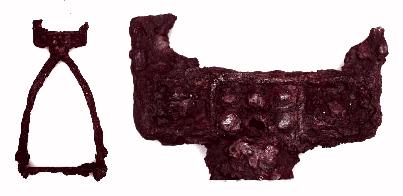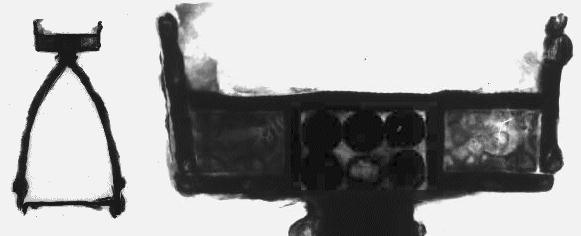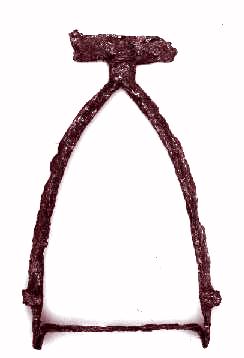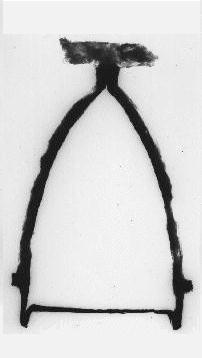CONSERVATION OF IRON: TREATMENTS AND THEIR CONSEQUENCES
Iron rusts when it is exposed to water and oxygen. The process is quicker
in the presence of salts, sodium chloride for example. Buried iron objects
are changed partly or entirely to corrosion products, which obscure the
object's original appearance. Significant traces of the original surface
may lie within this corrosion. The conservator's job is to stop or delay
further deterioration and to reveal the original surface, if it is safe
to do so. The processes used by the conservator alter the object's appearance
and may also change its physical and chemical structure.
X-ray photographs are a great help to the conservator and are used
extensively in this exhibition. Uncorroded iron appears dark on the image
and heavier metals used for decoration, such as silver on iron, appear
even darker.
Stirrups represent a relatively homogeneous group of objects.
We can use them to illustrate the development of conservation techniques
and conservation ethics during the last 150 years.
The stirrups shown in the following pictures were found together in
1849 and were conserved by V.F. Stephensen, Conservator at the National
Museum from 1867 to 1908. They were re-conserved by Rosenberg in 1911.
Some have been treated again in modern times. The evidence that we have
suggests that they all looked alike when they were found.

This stirrup (from Thorshøj) was first simply smeared with linseed
oil putty. Rosenberg treated it later in alternating baths of warm and
cold distilled water, until there was no trace of chloride (salt) ions
in the water. After that it was brushed clean and immersed in molten paraffin
wax, according to Krause's method of 1882. It has not been cleaned or treated
since. As a result the stirrup can still, 100 years after it was found,
be studied by archaeologists as a well conserved object.

An x-ray picture of the stirrup, with a close up of the upper part.
The silver ornamentation can be seen preserved within the corrosion layer.


An aggressive treatment can spoil the possibilities for future investigations.
Stephensen treated this stirrup with acid. He boiled it in sulphuric
acid until a white scum formed. Rosenberg re-treated the object electrochemically,
according to Krefting's method of 1892: The object is surrounded with granulated
zinc and immersed in sodium hydroxide solution until the corrosion is removed.
The result: Rosenberg remarks in the margin of the museum's register: "...almost
no surface left."
All corrosion and ornamentation has vanished. Only the iron core is
left (x-ray picture on the right).
Next showcase....



